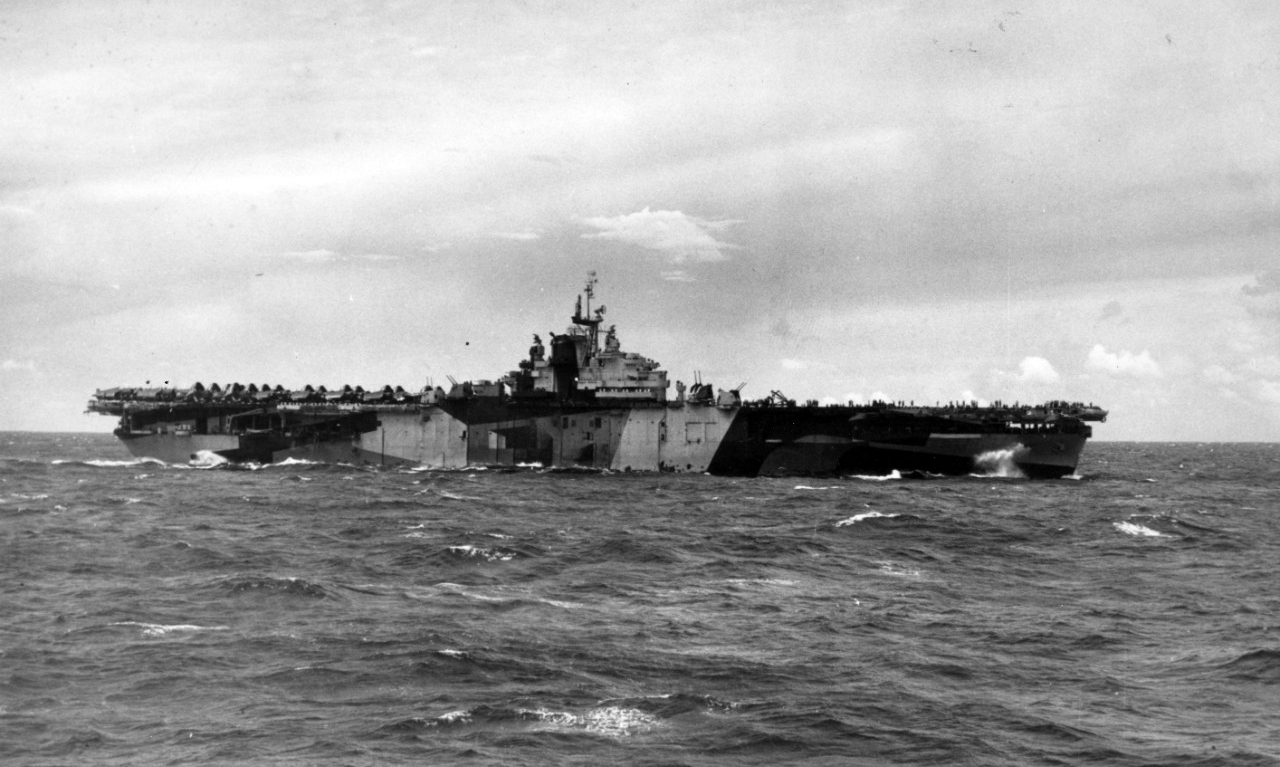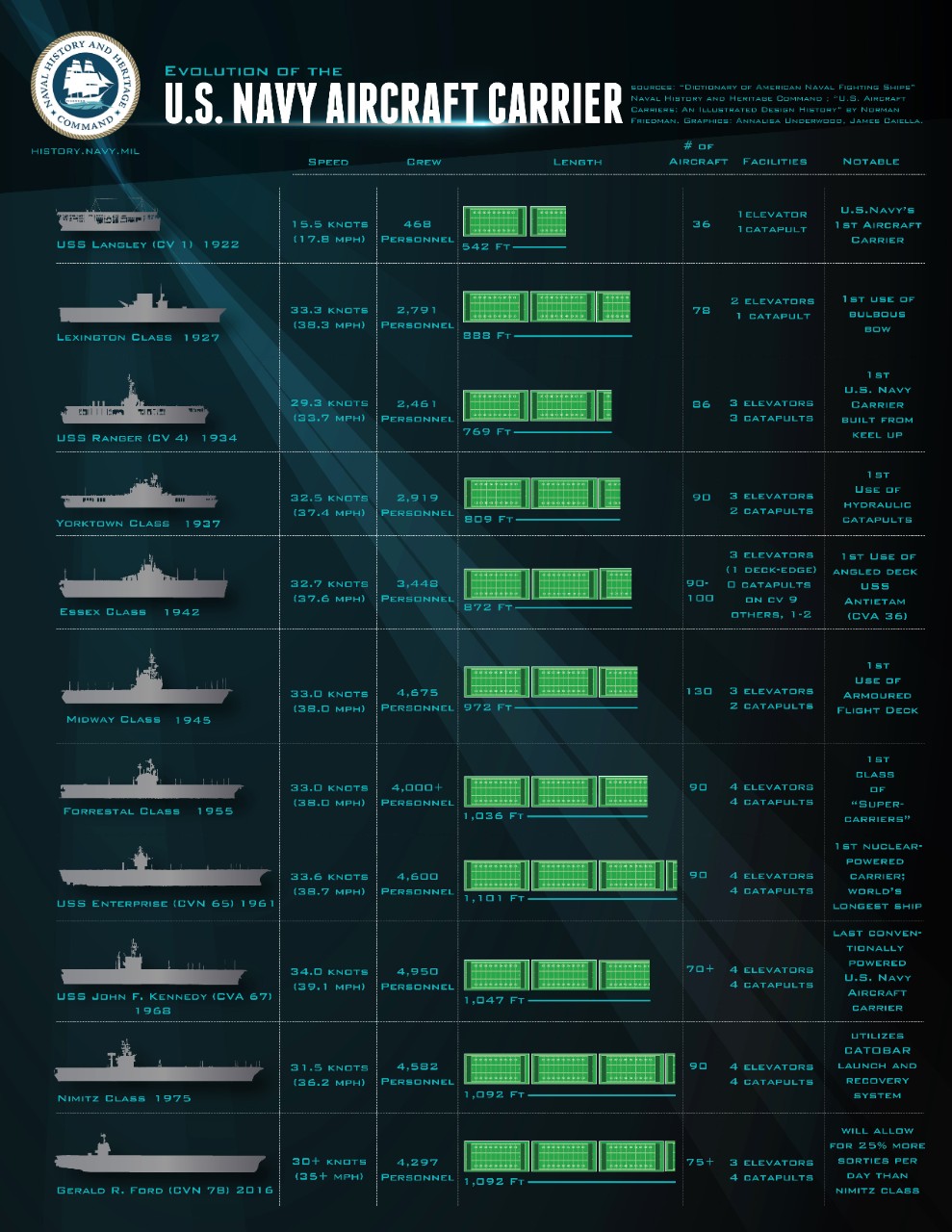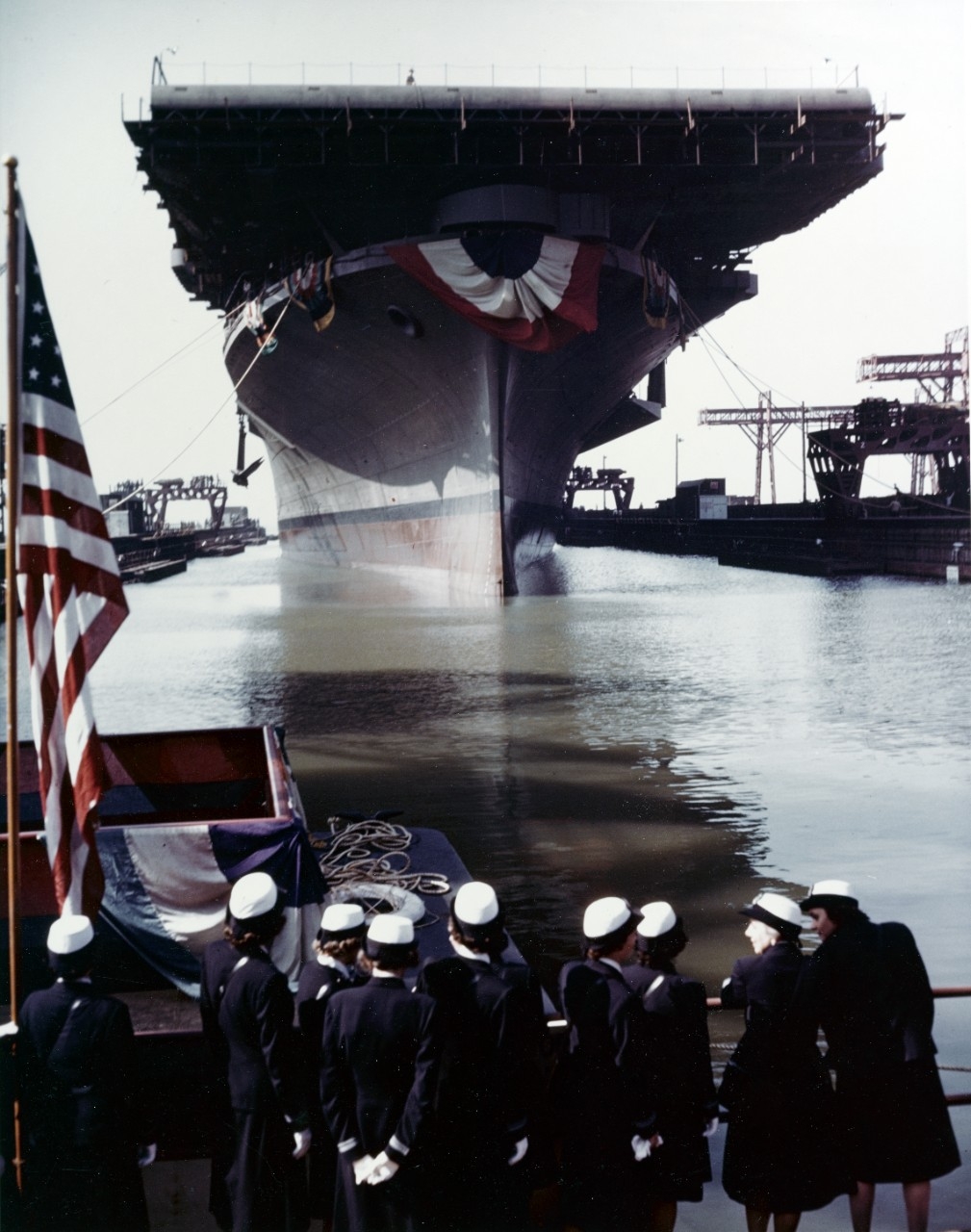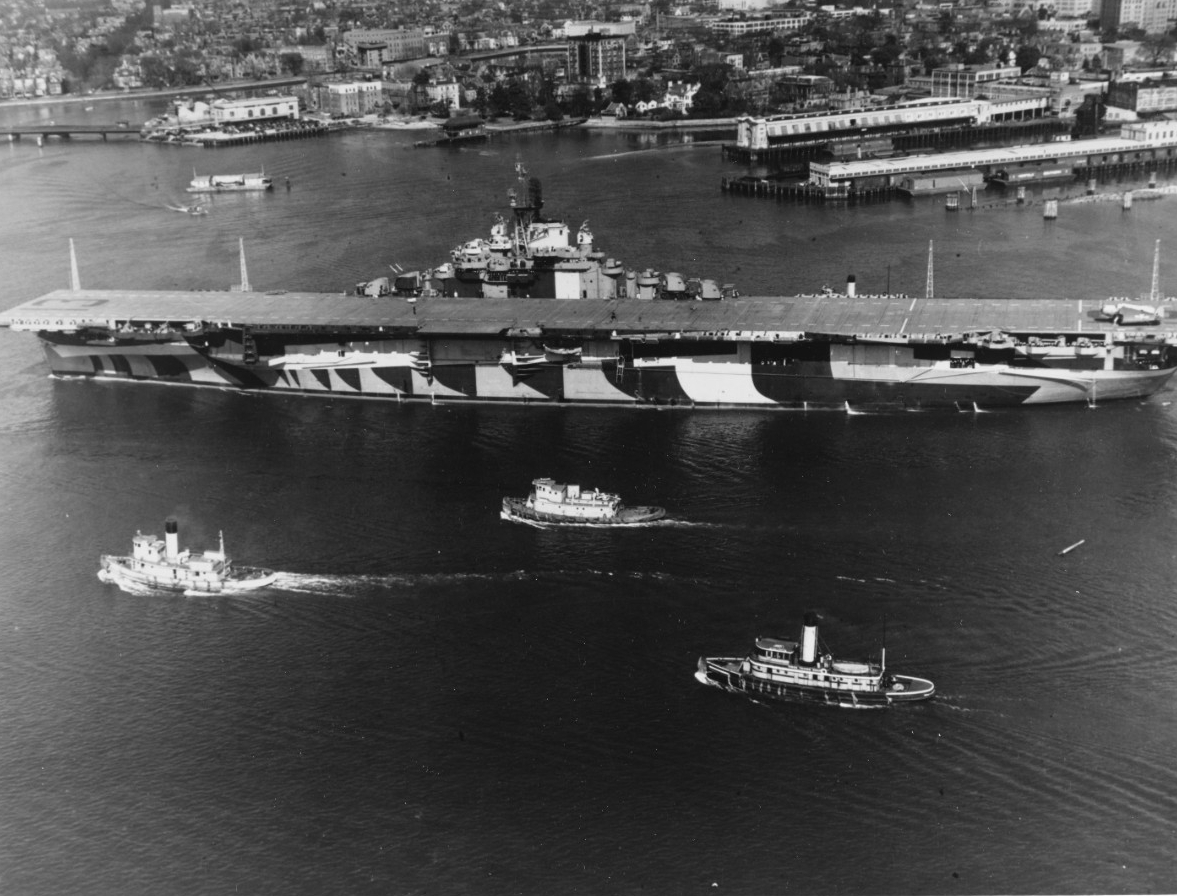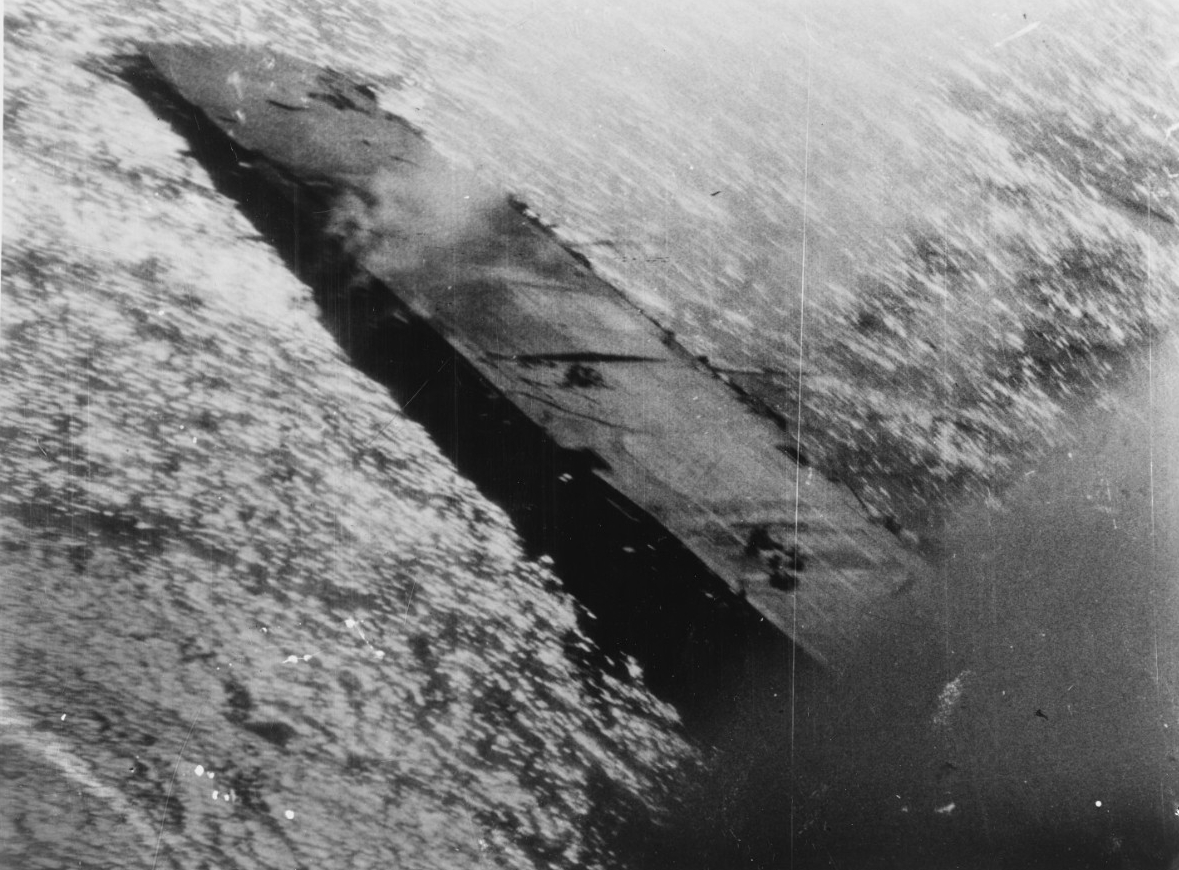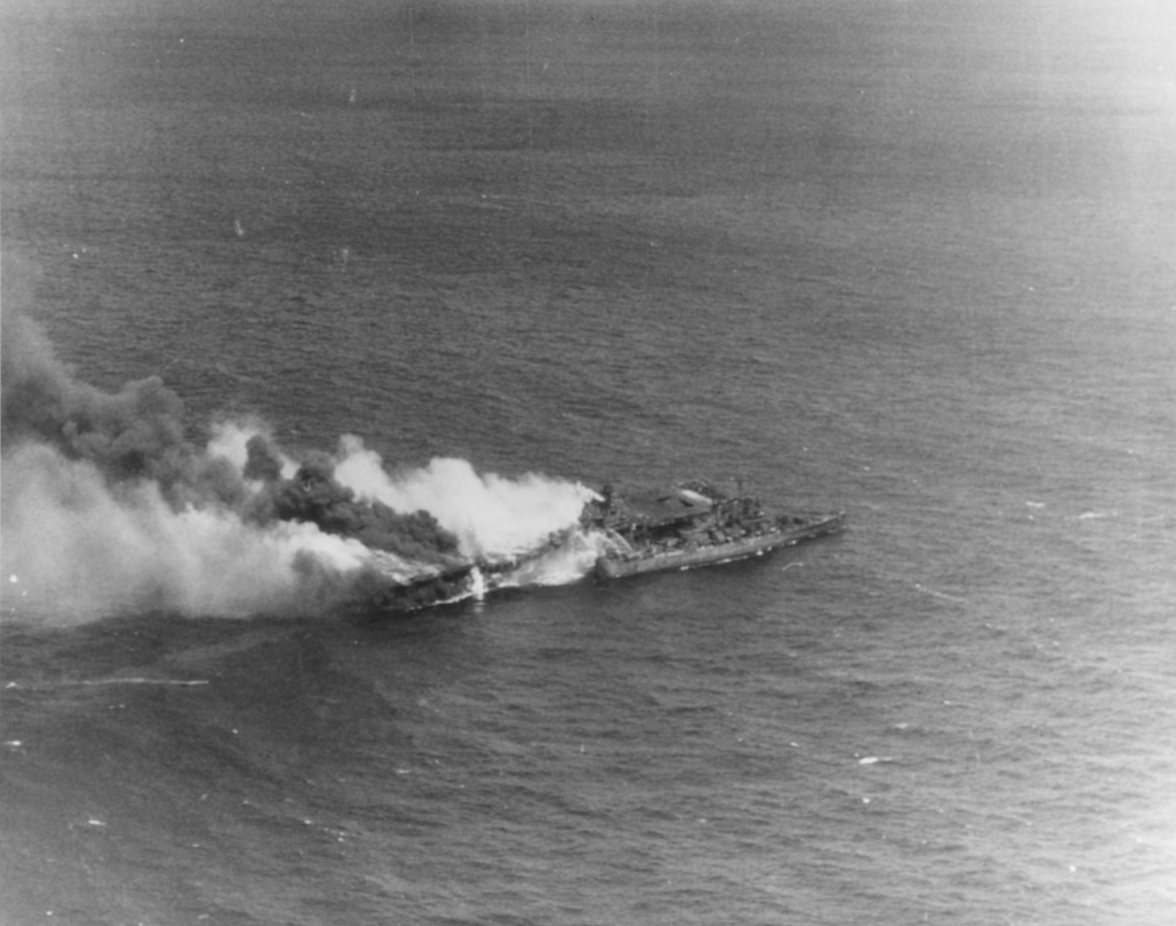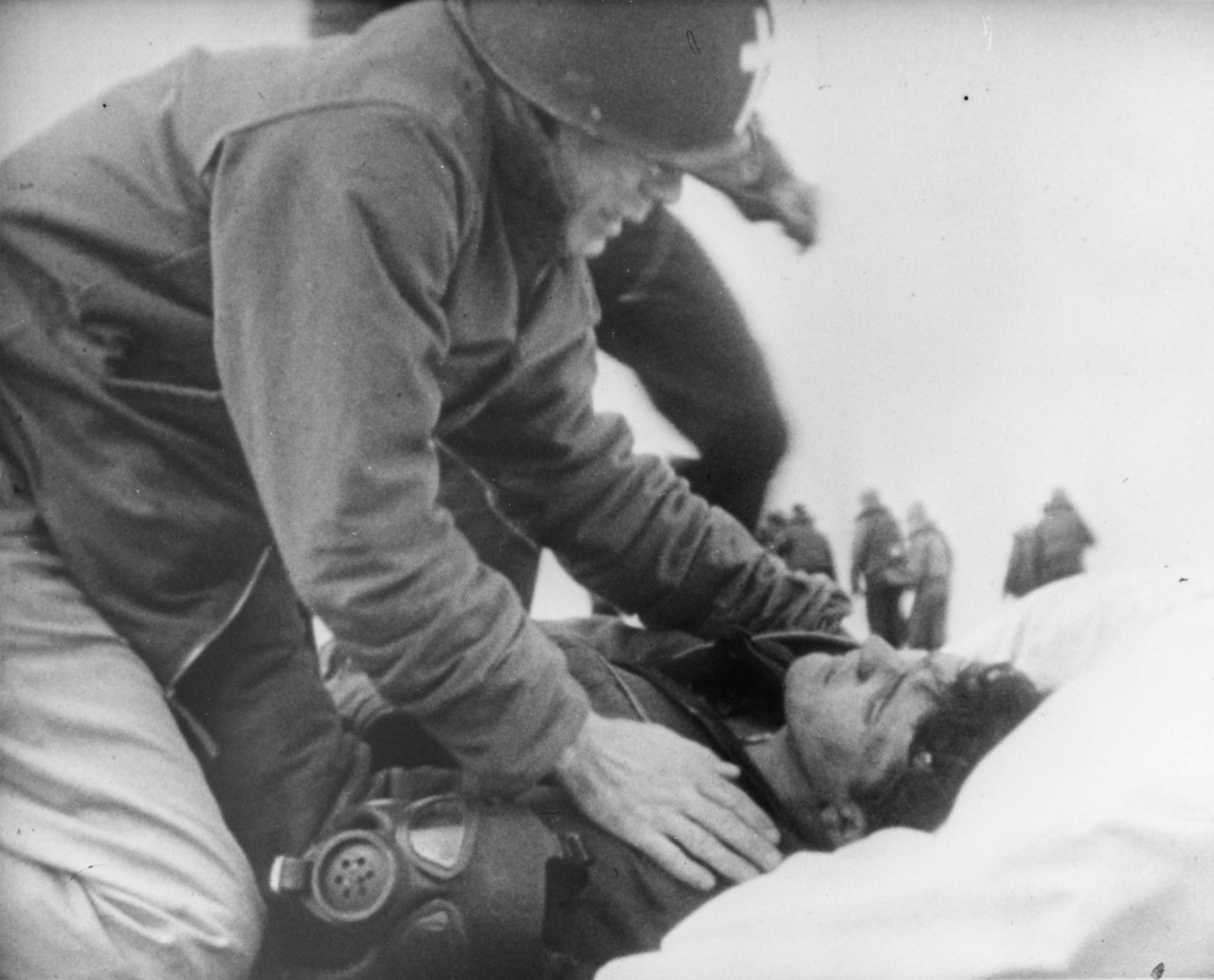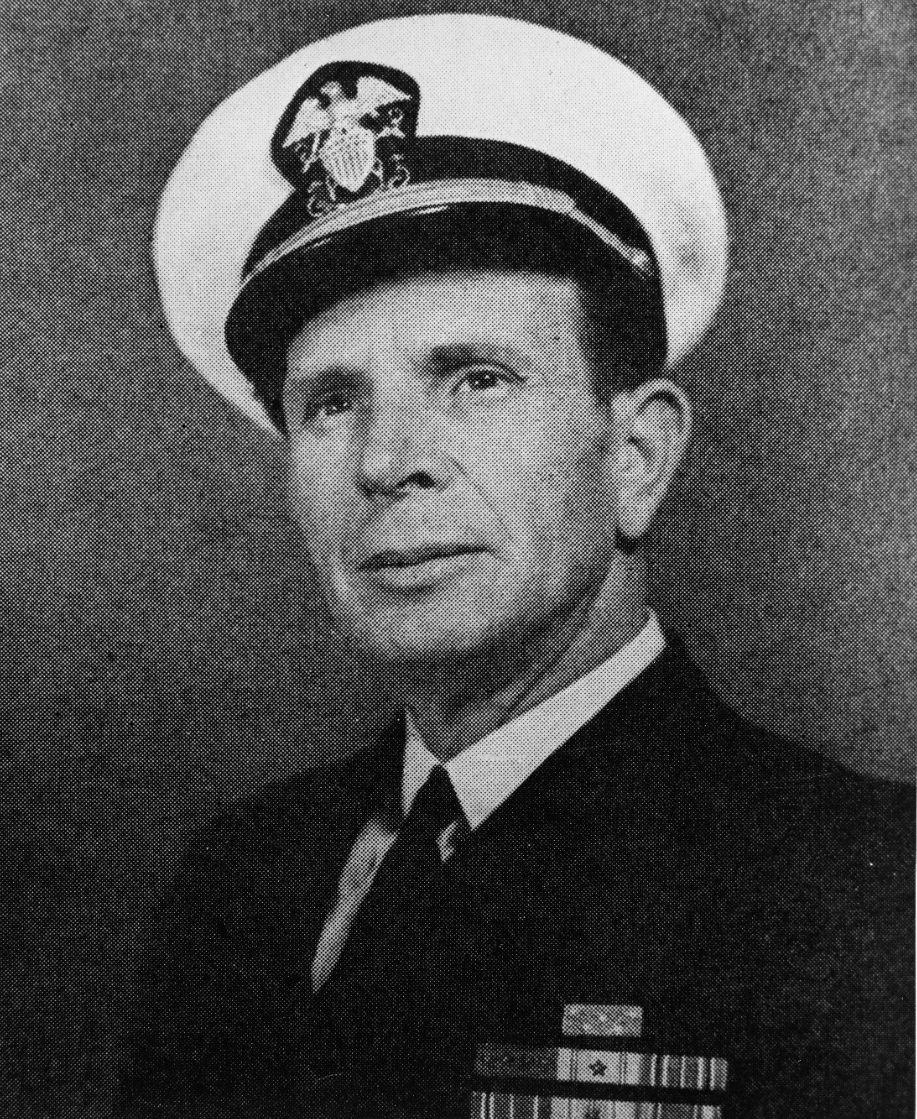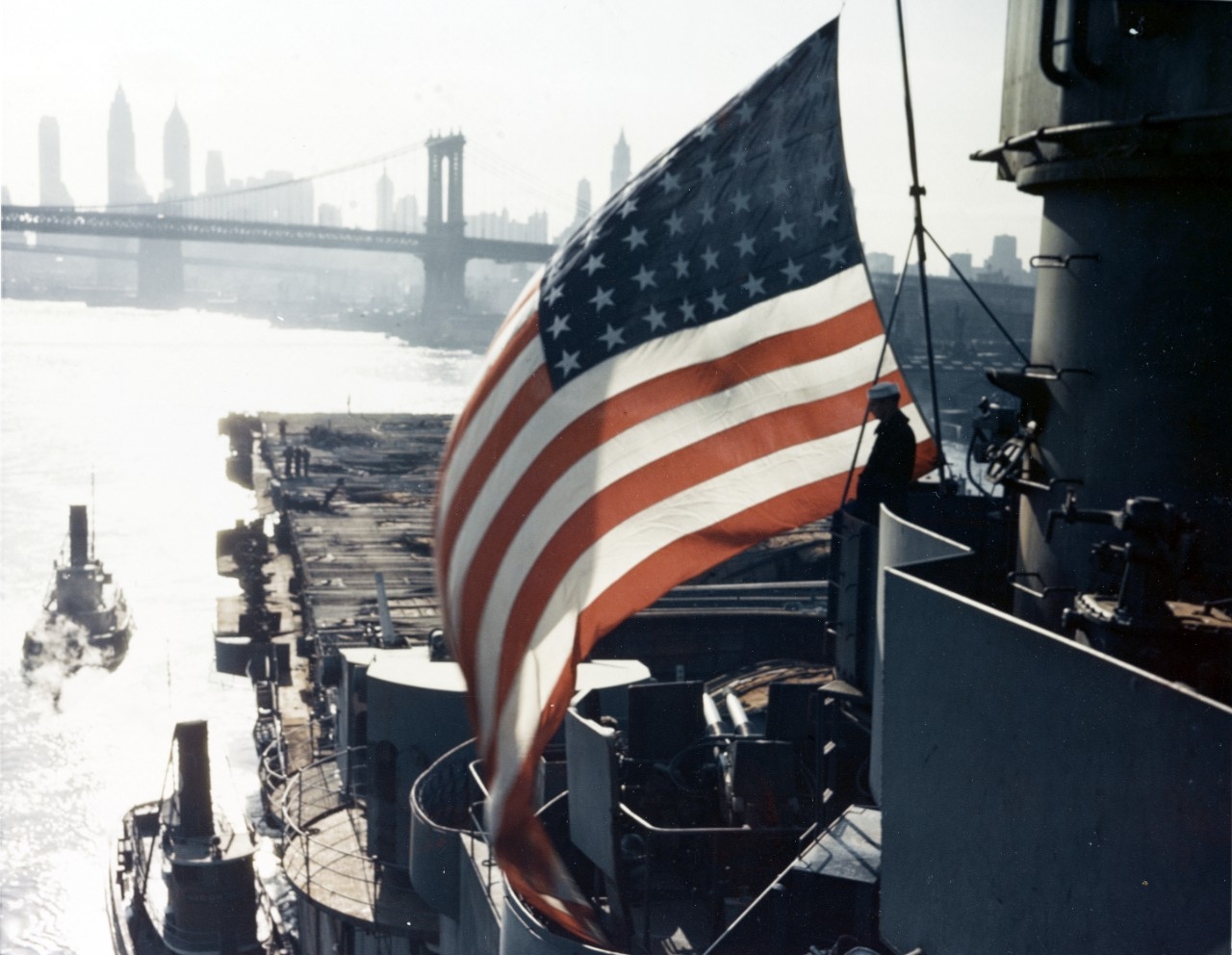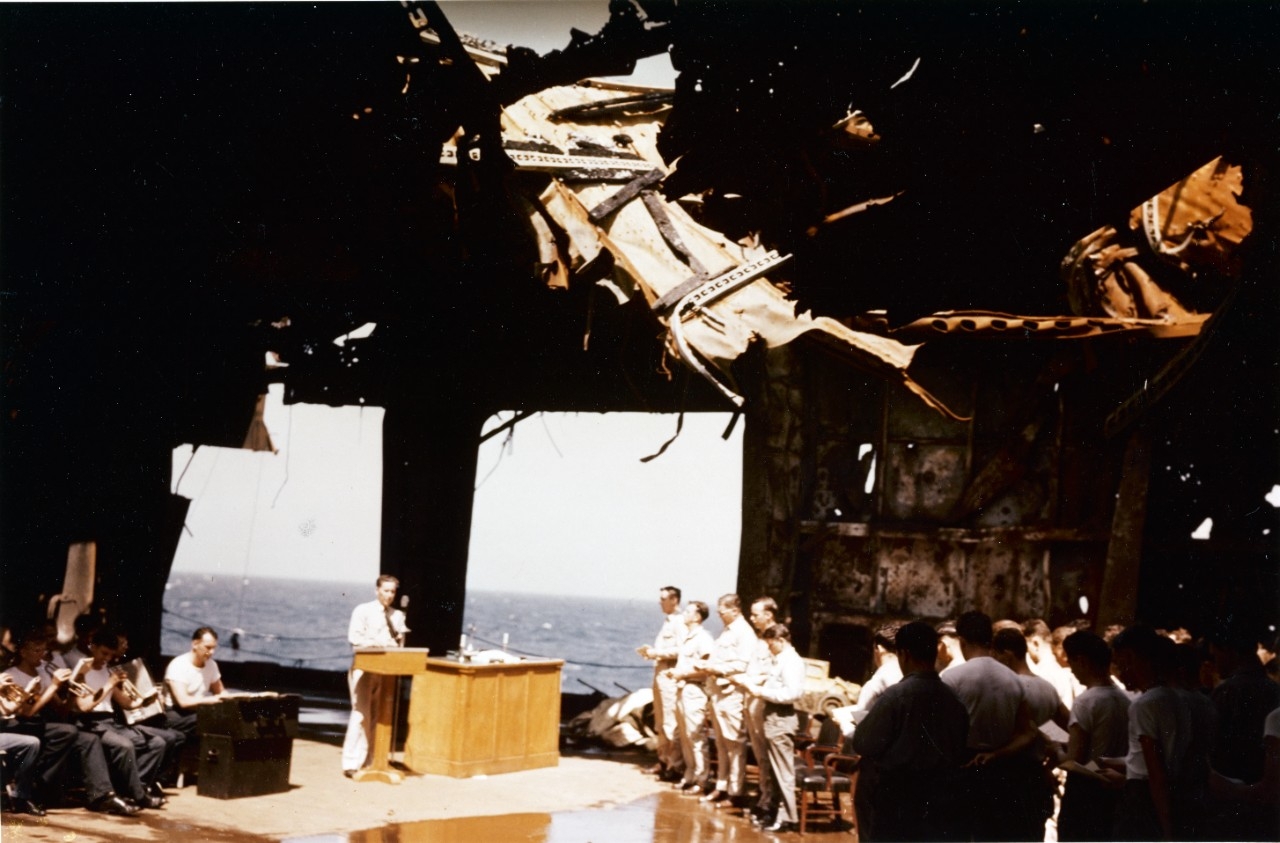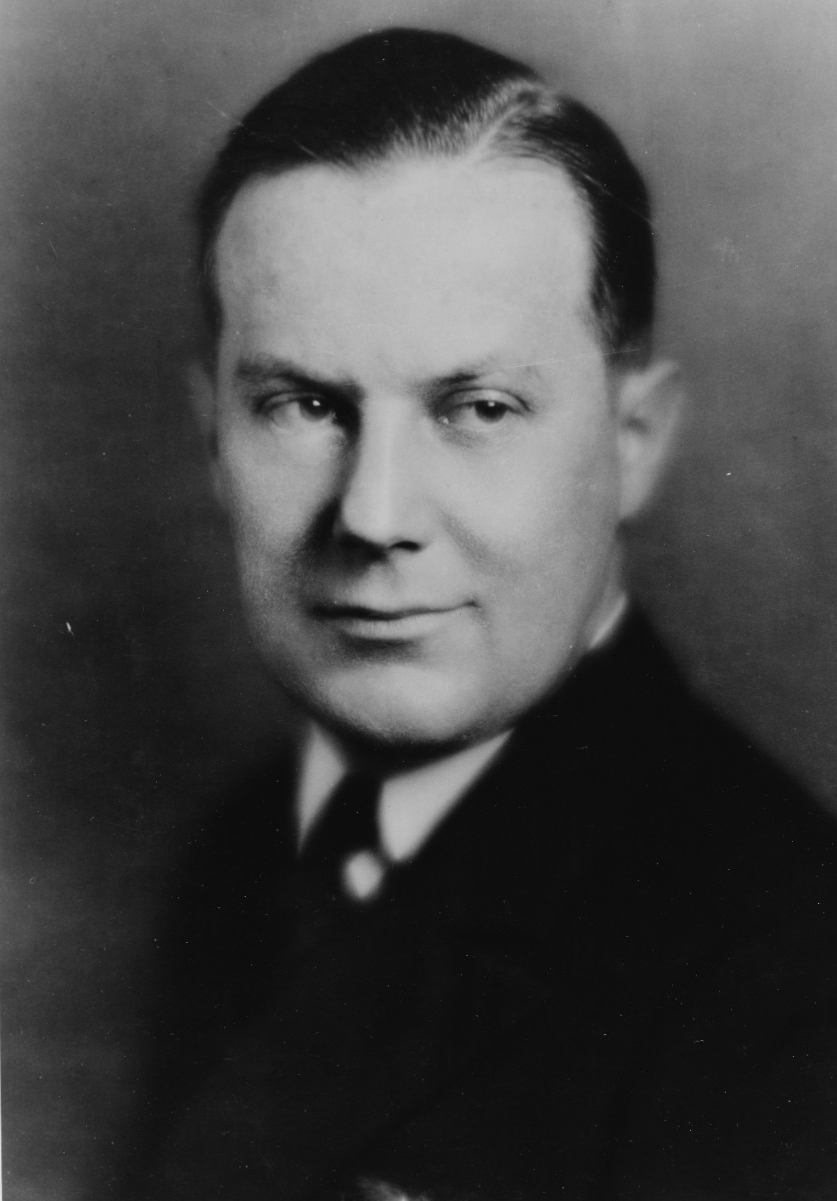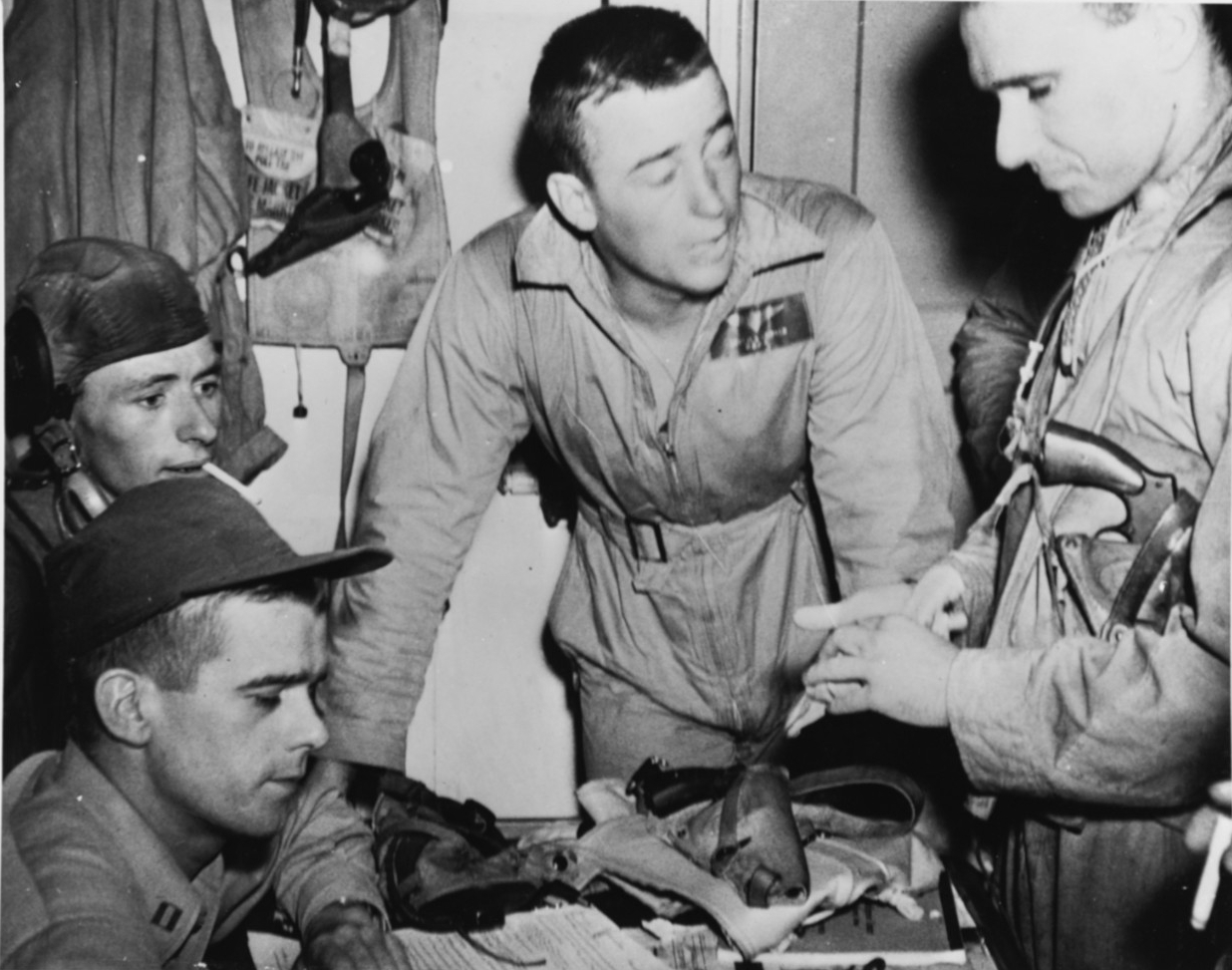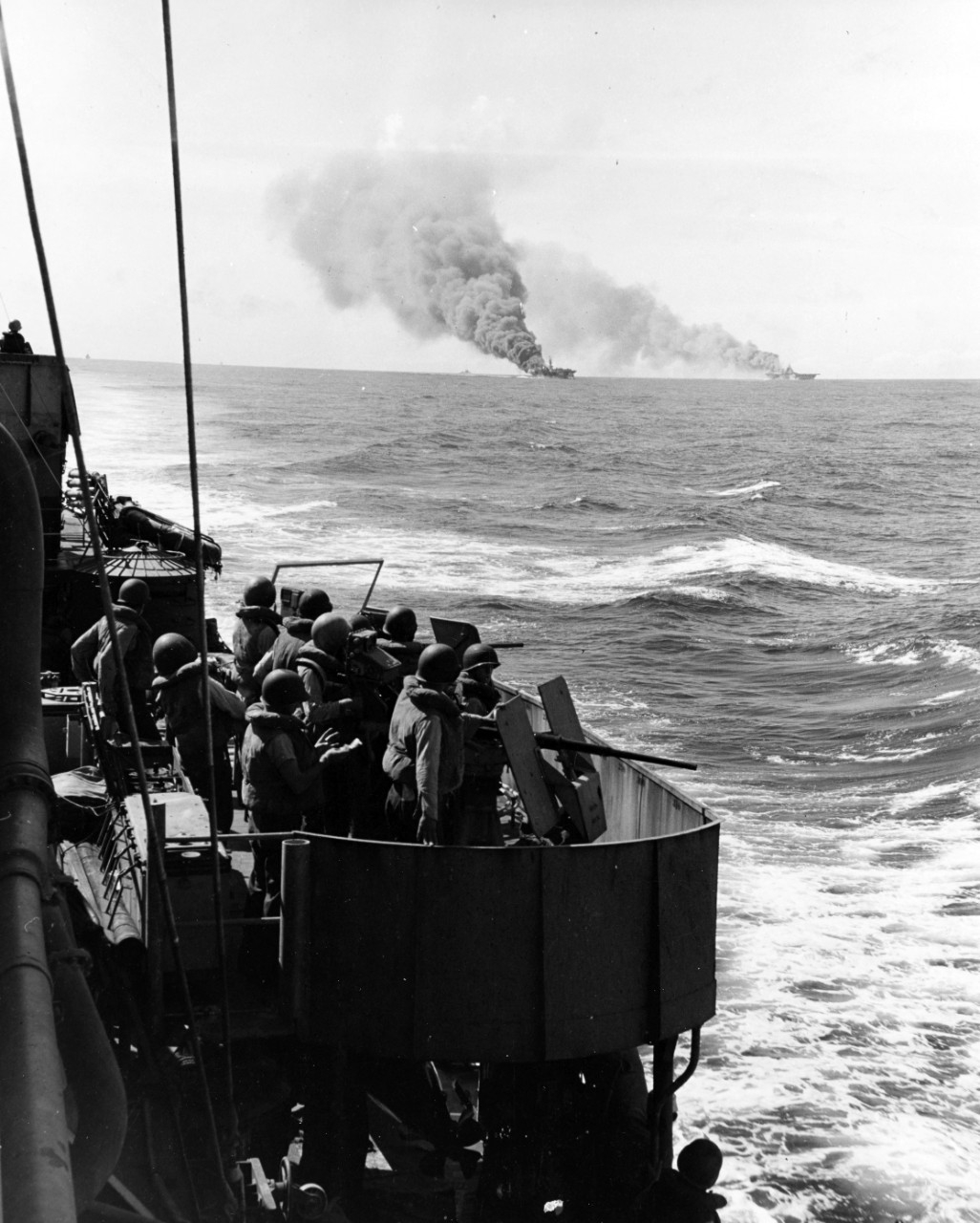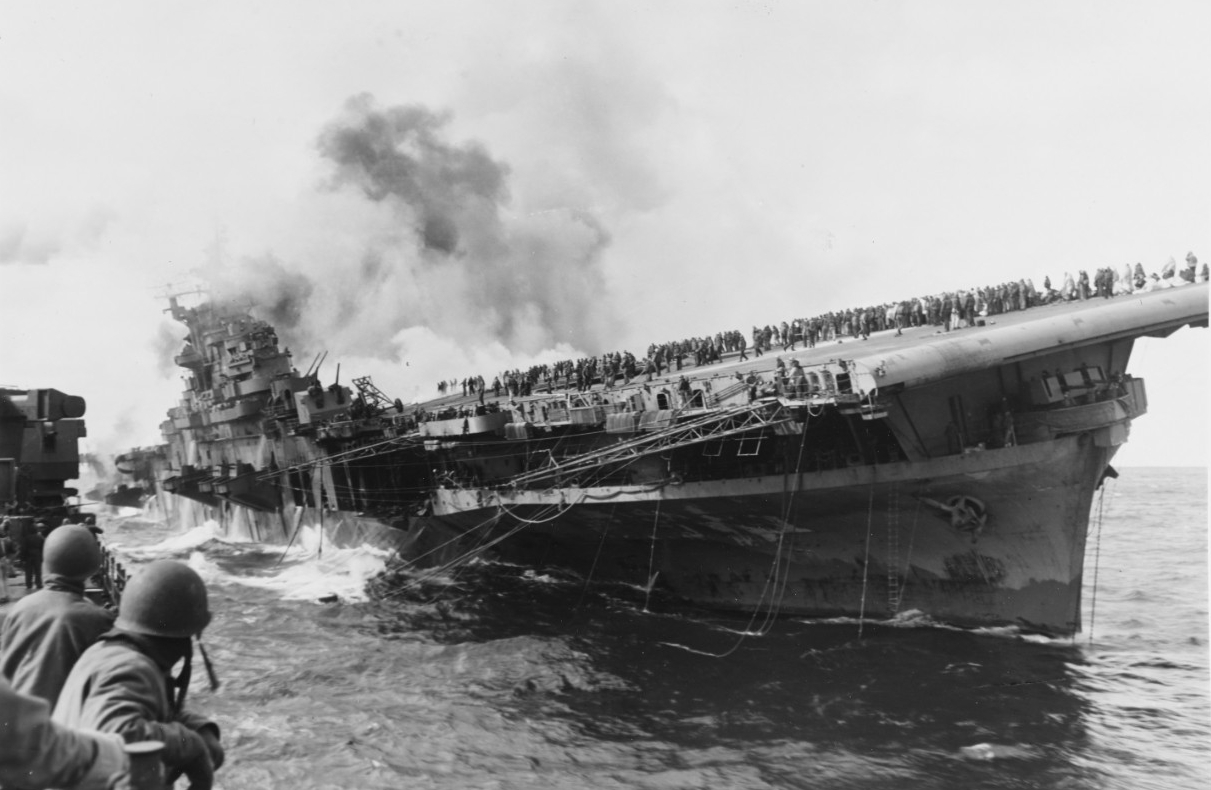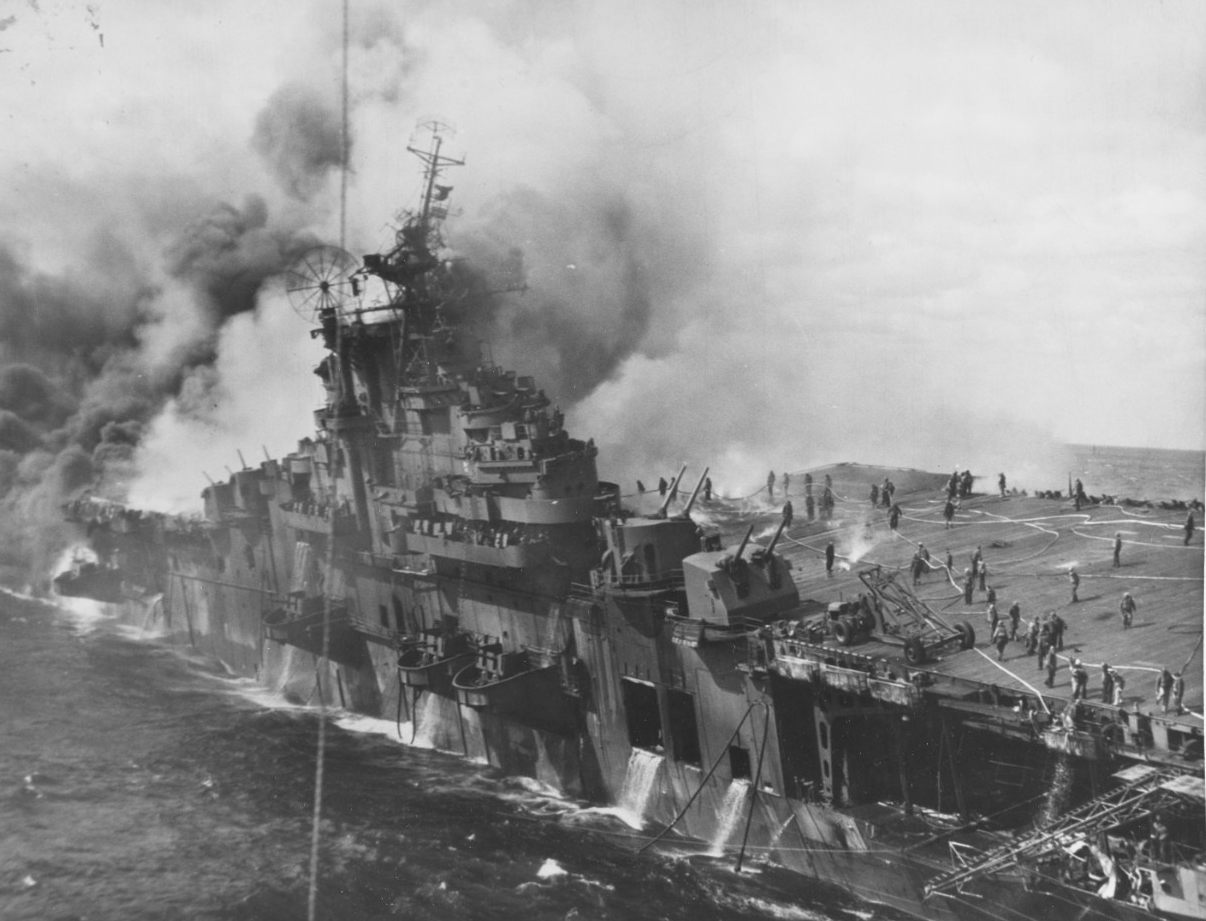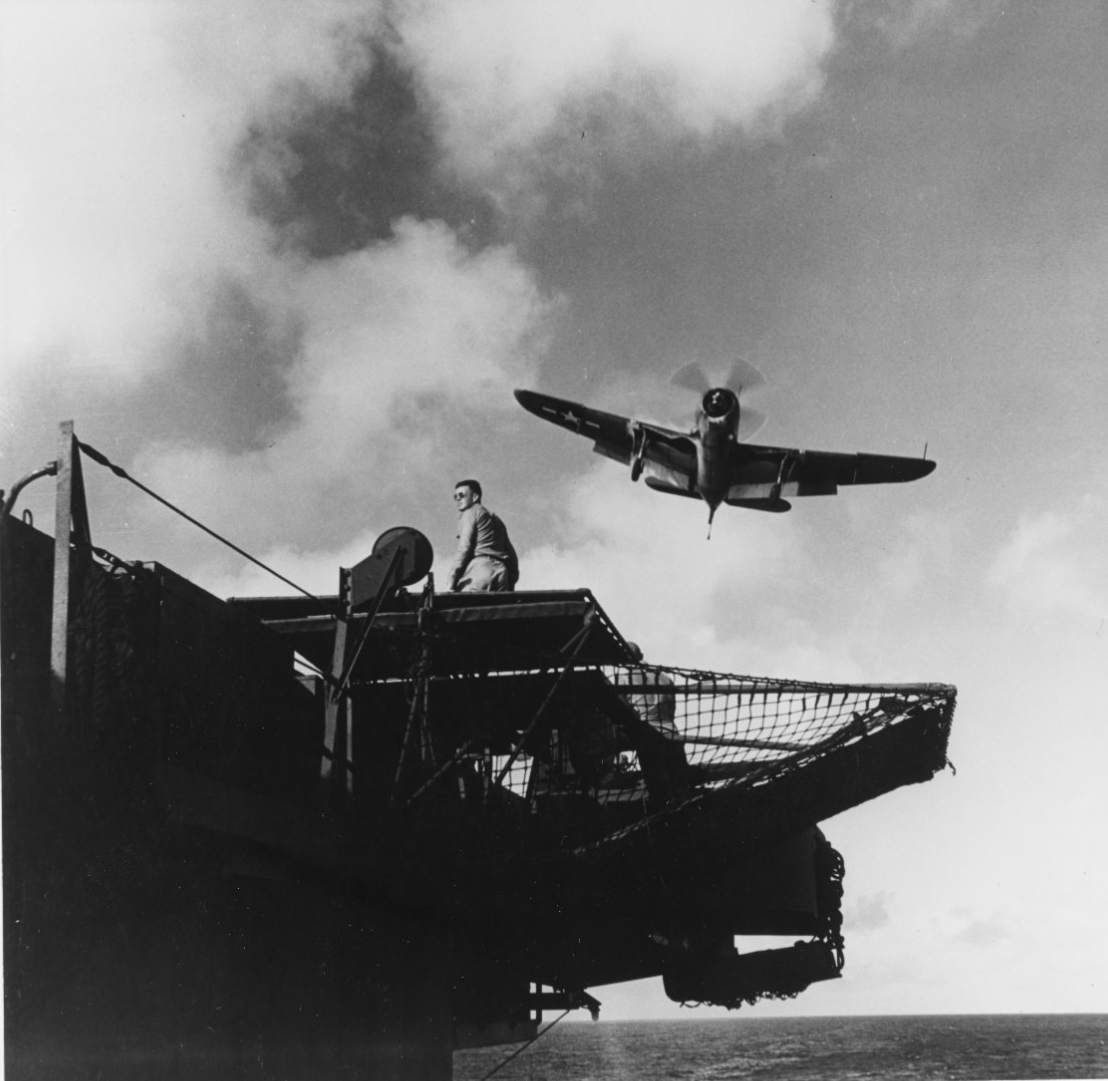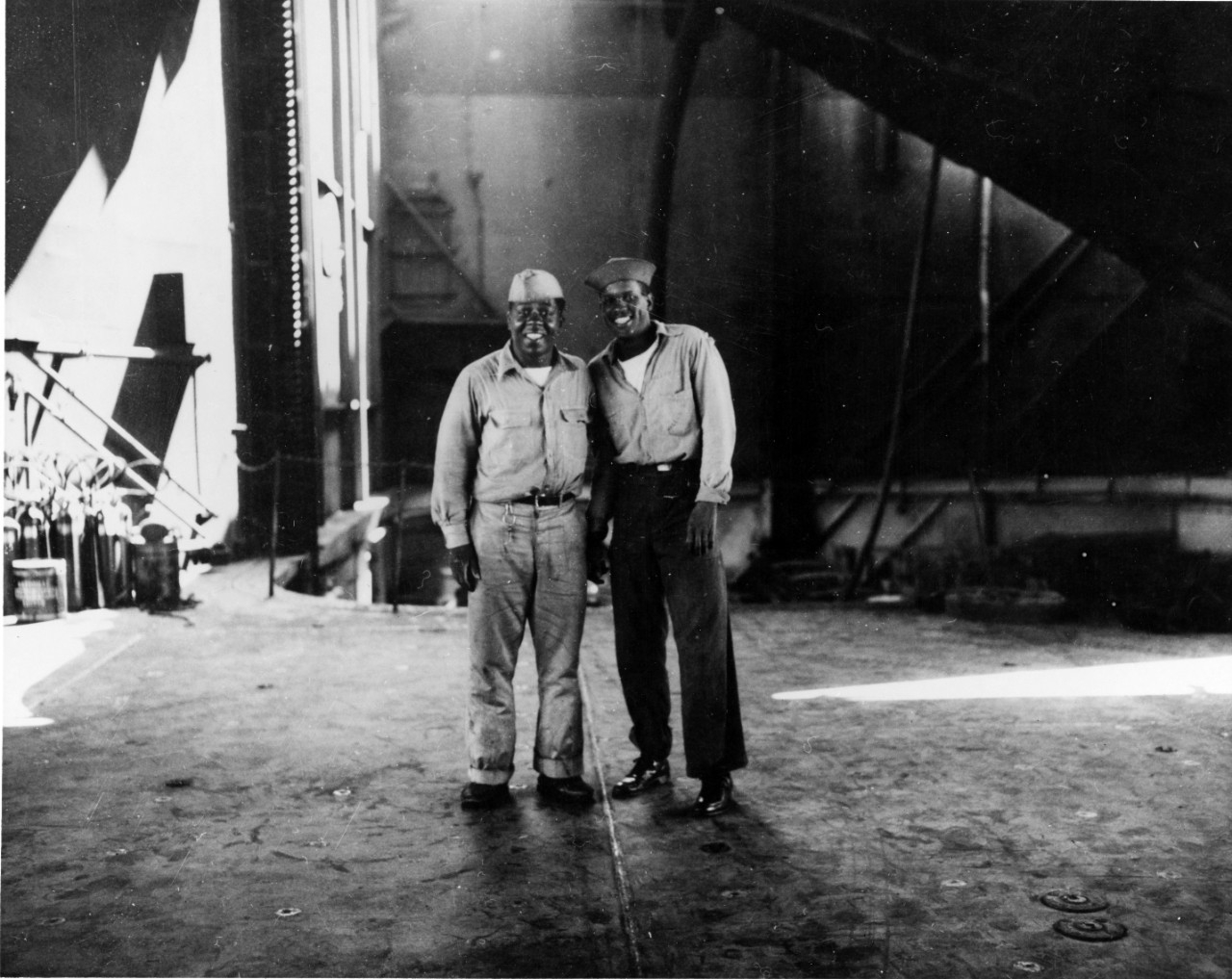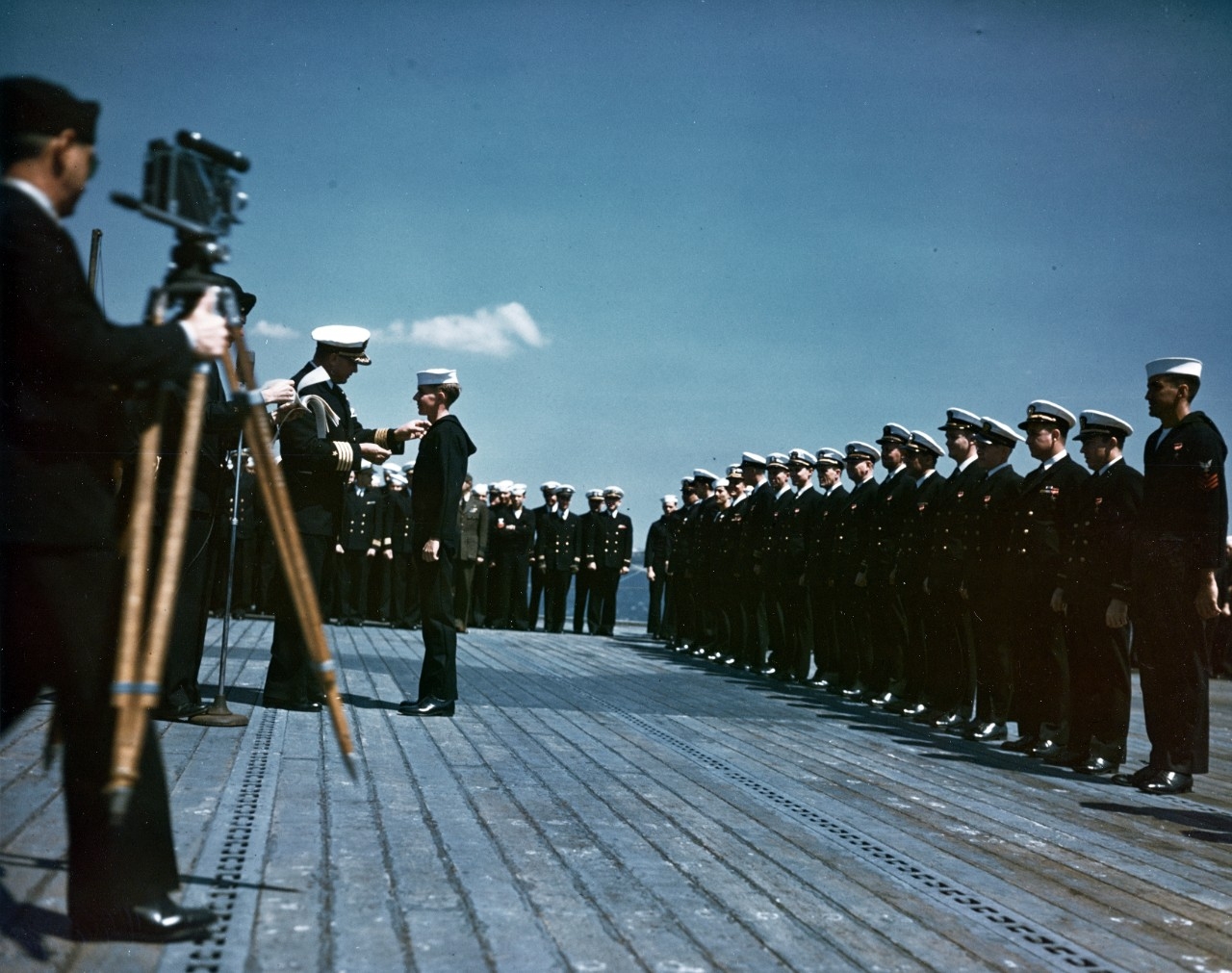USS Franklin (CV-13)
“Big Ben”
Named to honor Founding Father Benjamin Franklin, Essex-class aircraft carrier USS Franklin (CV-13) was commissioned at the Norfolk Navy Yard, Portsmouth, Virginia, on 31 January 1944 with Captain James M. Shoemaker in command. After trials and gunnery drills in the Chesapeake Bay, Franklin conducted a month-long shakedown cruise in the Caribbean Sea before returning to Norfolk for repairs and replenishment. On 5 May, Franklin was underway for her first wartime deployment. Escorted by destroyers USS Twiggs (DD-591), USS Leary (DD-158), and USS Cushing (DD-797), the aircraft carrier steamed to San Diego, California—via the Panama Canal—where she underwent post voyage repairs in preparation for upcoming operations in the Pacific. On 1 June, Franklin was underway for Pearl Harbor, arriving five days later. On 16 June, the aircraft carrier reported for duty with Task Group (TG) 58.2, commencing her first mission as part of a fast carrier strike force. As part of the reserve force for Fifth and Seventh Fleets, Franklin steamed to Eniwetok Atoll, Marshall Islands, entering the circular lagoon on the evening of 21 June.
With Operation Forager well underway, Franklin prepared to attack the Bonin Islands. On Independence Day 1944, just 82 miles from the remote island of Iwo Jima, Franklin launched 16 aircraft that downed multiple enemy airborne fighters in the area of operations. Subsequent strikes sent 160 sorties against Iwo Jima and 30 more against Haha Jima. During the day, Japanese gun emplacements, airfields, hangars, barracks, and shipping at both locations underwent heavy bombardment, however, Franklin lost four aircraft in the fighting. In the losses, the pilots and crew were rescued with the exception of two—Lieutenant Milton J. Bonar and Aviation Radioman 3rd Class Albert D. Lenthal. During that night, Franklin proceeded to another launching point off Japanese occupied Guam. On the afternoon of 6 July, the carrier sent a fighter sweep against Orote Field on Guam that damaged several enemy buildings. However, during the attack, naval aviators encountered heavy anti-aircraft fire that resulted in the loss of one of Franklin’s F65-5 Hellcat fighters. The pilot and his wingman were later rescued out at sea in a rubber boat about two miles north of Ritidian Point. The following day, Franklin steamed to an alternate striking position southwest of Guam, where she commenced a daily series of strikes that destroyed enemy military installations and fortifications ashore. The tempo of the air bombardments continued—sometimes accompanied by surface fleet shelling—until they reached a crescendo on 21 July when U.S. amphibious forces stormed the island. Franklin’s aircraft continued to support the landings throughout the next day, until, “due to an exhaustion of the bomb supply,” the carrier headed north to Garapan Anchorage, Saipan.
After the carrier was refueled and re-provisioned with ordnance, Franklin joined TG 58 as they steamed for an assault on the Palau Islands. On 25 July, Franklin launched a 16 plane fighter sweep that downed three airborne enemy aircraft and damaged several others on the ground. The following day, the carrier conducted four strikes against the islands of Babelthuap, Koror, and Malakal, wreaking havoc on Japanese shore installations and shipping. For the next few days, Franklin’s aircraft continued bombardment operations against Palau that destroyed enemy air facilities, anti-aircraft positions, and harbor installations. After operations were complete, Franklin steamed towards Saipan and later anchored at Garapan Roads for replenishment. On 2 August, the carrier made way for the Bonin Islands where her aircraft strafed Japanese shipping and airfields causing significant damage on Chichi Jima. Due to bad weather, Franklin was forced to scrub additional strikes and the task group shaped a southeasterly course headed for Eniwetok, Marshalls. She remained at Eniwetok for the remainder of August for upkeep and a recreation period for the crew.
On 1–2 September, Franklin’s aircraft conducted strikes again on Iwo Jima that resulted in the destruction of an estimated 11 airborne and 41 grounded enemy planes. After she briefly anchored at Saipan, Franklin’s aircraft launched 18 planes over Yap Island on 6 September, however, the aviators encountered no enemy aircraft and found the island to be in shambles from earlier raids. Nevertheless, she continued to execute bombing raids on the island for the next few days encountering some resistance. On 9 September, Franklin departed Yap and made way for Palau arriving within striking distance of Peleliu Island the following day. Franklin’s air group then began bombing the island, conducting four or more air strikes a day for the next five days in order to “soften the island’s defenses,” in preparation for an amphibious landing planned for 15 September. On the morning of the invasion, waves of Marines landed on the beaches as Franklin’s air group worked tirelessly to maintain air superiority, suppress enemy shipping, and bomb defensive fortifications. She continued to support the invasion until 21 September when she steamed for the Admiralty Islands for replacement bombers.
On 10 October, Franklin arrived 100 miles south of Okinawa, and just before dawn, launched a 12 plane fighter sweep on the island. Then, 20-minutes later, the air group commenced the first of two bombing runs, which in all, sent four deck loads of torpedo planes, fighters, and dive bombers out against the enemy. The following day, Franklin set course for Aparri, Luzon, Philippines, to attack an enemy airfield that ultimately destroyed several Japanese aircraft on the ground. On 12 October, in company with TGs 38.1.2 and 38.1.3, Franklin steamed towards Formosa [Taiwan] where she launched a fighter sweep, as well as several bombing runs. Over the course of the day, Franklin’s aircraft destroyed multiple enemy aircraft in the air and many more on the ground. Franklin continued to attack enemy forces for the next few days before the carrier departed the area to support a planned amphibious assault on Leyte. On 20 October, the U.S. Sixth Army commenced landings. Franklin’s aircraft directly supported “boots on the ground” as they moved ashore. The following day, Franklin steamed to a refueling point in the Philippines, as other carriers in the area continued air support operations in the Leyte assault.
On 23 October, Franklin’s commander received word of a large Japanese naval force in the Palawan Passage—effectively commencing the Battle of Leyte Gulf. In response to the Japanese counterattack, Admiral William F. Halsey, Jr., ordered multiple task groups to intercept the approaching enemy force. Steaming east of Samar Island, Franklin launched its first wave of attacks on the morning of 24 October. Later that day, Franklin launched another 32 planes to attack the main body of the enemy fleet, which had been located in the area of the Sibuyan Sea. Aircraft from Franklin, USS Enterprise (CV-6), and USS Intrepid (CV-11) subsequently sank Japanese super-battleship Musashi and damaged battleships Fusō and Yamashiro. Franklin’s planes also sent the destroyer Wakaba to the ocean’s floor. The following day, aircraft from carriers in the area sank Zuikaku, Zuihō, and heavily damaged Chiyoda that was later sank by cruiser gunfire. On 26 October, as the Battle for Leyte Gulf drew to a close, U.S. Navy and U.S. Army Air Force aircraft continued to pursue the retiring Japanese fleet. Franklin remained in the area for the next few days to search for surviving aviators, who had been shot down. The aircraft carrier departed the area on 30 October to refuel off Samar Island. Later that day, Franklin received an urgent message from a nearby fleet tanker that reported they were under attack. Franklin’s crew went to general quarters, and as soon as aircraft left her flight deck, the ship came under an enemy bombing attack. Six Japanese planes identified as a mixture of Zekes and Yokosuka came in at high speeds targeting Franklin and USS Bagley (DD-386). One of the Zekes intentionally crashed on Franklin’s flight deck causing a massive explosion followed by ferocious fires that swept by the nearby planes on the flight and hanger deck. The fires continued to rage until the crew got them under control later that evening. In total, 56 of Franklin’s crew were killed and another 60 were wounded in the kamikaze attack. In wake of the attack, Franklin set course for Ulithi Lagoon, Caroline Islands, were she underwent temporary repairs. The ship ultimately made way for the Puget Sound Navy Yard, Bremerton, Washington, where she went into dry dock to repair extensive battle damage.
In March 1945, Franklin departed Pearl Harbor to conduct the first carrier strikes of the war against the Japanese home islands of Kyūshū and Honshū, as well as to support troop landings at Okinawa. Arriving within 100 miles of the Japanese mainland on 18 March, Franklin participated in air strikes that targeted the Japanese cities of Kagoshima and Izumi located on the southern end of Kyūshū. During the initial attacks, aircraft from Franklin downed 17 Japanese planes in the air and seven others on the ground. In addition, they damaged an airfield, shipping, and two locomotives. The next day, TF-58 destroyed submarine I-205, while still in dry dock, and damaged battleships Yamato, Haruna, and Hyūga; carriers Amagi, Hōshō, Ikoma, and Katsuragi; light carrier Ryūhō; escort carrier Kaiyō; heavy cruiser Tone; light cruiser Oyodo; submarines I-400 and RO-67; and escort destroyer Kaki.
During the morning of 19 March, Franklin received an urgent message from USS Hancock (CV-19) that a twin engine enemy plane was closing in on “Big Ben” (affectionally nicknamed by the Franklin crew). Minutes later, a Japanese bomber emerged from a bank of clouds. Despite the gunners’ efforts, the plane managed to hit Franklin with both of its 550-pound, semi-armor piercing bombs. One of the bombs hit the flight deck and penetrated through to the hanger deck where it exploded on impact. The explosion, tragically, instantly killed all the crewmembers located at the forward part of the hanger deck. The second bomb struck the flight deck, which started a series of uncontrollable fires that ignited multiple planes in the process of taking off. The initial explosions were followed by five-hours of heavier detonations that “turned up five bombers, 14 torpedo planes and 12 fighters,” all loaded with medium load, general purpose bombs and “Tiny Tim” rockets. Although the ship’s commander was advised to “abandon ship,” he did not take action, because he believed his crew could save the ship. By 9 a.m., the task group commander and his staff were evacuated from Franklin. Shortly thereafter, the light cruiser USS Santa Fe (CL-60) came alongside Franklin and began removing injured Sailors. In addition to the 103 wounded, nearly 795 other Sailors were evacuated. The carrier took on a list of about three degrees to starboard and lost all headway as it lay dead in the water. Meanwhile, USS Hickox (DD-673) and USS Miller (DD-535) assisted in picking up hundreds of other survivors that had been either driven or blown overboard by the explosions and fires. Despite the evacuations and casualties, 106 officers and 604 enlisted Sailors remained onboard Franklin in the fight to keep her afloat.
Later that day, heavy cruiser USS Pittsburgh (CA-72) “shackled a towing wire to the outboard end of Franklin’s starboard anchor chain,” and Hellcats from Enterprise provided air cover. Although most of the fires were under control, Franklin developed a 13-degree list to her starboard. Struggling through the water, then just 50 miles off the coast of Japan, Franklin remained in great danger. In fact, only two hours into her tow, she was attacked by a Japanese Judy, which fortunately, was driven off by anti-aircraft fire. Through the crew’s valiant efforts to save the ship, quite fittingly, she thereafter became known as “The Ship That Wouldn’t Die.” Nonetheless, Franklin’s tragic bombing resulted in a devastating number of casualties—796 killed and another 265 wounded. Eventually, Franklin regained steering control and was able to make it to Ulithi Lagoon on 24 March before she returned to the United States, arriving at the New York Navy Yard on 28 April.
A number of the crew distinguished themselves during the tumultuous 19 March attack. Lieutenant Commander Joseph T. O’Callahan, the ship’s Roman Catholic chaplain, consoled many of the dying men and encouraged others to fight the fires and save the ship. Lieutenant (j.g.) Donald A. Gary managed to lead 250–300 crewmembers to safety, who were trapped below deck. Both O’Callahan and Gary later received the Medal of Honor for their heroic actions on that day. The following month, the first awards for valor were presented to the crew of the ship. As a whole, Franklin’s Sailors became one of the most decorated crews in U.S. Navy history. Collectively, in addition to the two Medals of Honor, they received 19 Navy Crosses, 22 Silver Stars, 116 Bronze Stars, 235 Letters of Commendation, and more than 1,100 Purple Hearts.
When the Japanese surrendered, Franklin was still undergoing repairs. Her extensive repairs were finally completed the following year, and later she reported to the Atlantic Reserve Fleet for inactivation. On 17 February 1947, the carrier was placed out of commission at Bayonne, New Jersey. Franklin never returned to active service, although she was redesignated several times. On 1 October 1952, she became an attack aircraft carrier (CVA-13), on 8 August 1953 an antisubmarine warfare support carrier (CVS-13), and on 15 May 1959 an aircraft transport (AVT-8). Franklin was eventually sold to the Portsmouth Salvage Company in August 1966.
Franklin received four battle stars for her outstanding service during World War II.
*****
Suggested Reading
- Naval Aviation
- Surface Navy
- Evolution of Aircraft Carriers
- H-Gram 032: Operation Forager and the Battle of the Philippine Sea
- H-Gram 038: Battle of Leyte Gulf
- H-Gram 042-1: The Ship That Wouldn’t Die—USS Franklin (CV-13), 19 March 1945
- Navy Flight Surgeon on USS Franklin (CV-13)
- Casualty Report, USS Franklin (CV-13), 7–21 October 1944
- USS Franklin (CV-13) War Damage Report No. 56
Interviews with USS Franklin (CV-13) Crewmembers
- John E. Reves
- David Baruch
- Warren Duke
- Melvin V. Laws
- Donald Rodde
- Richard W. Townsend
- Lyle E. Butler
- Samuel N. Rhodes, Jr.
- Robert Freggens
- Joseph J. Eisenhuth
- William A. McClellan
- Richard B. Ferris
Video Footage
- Action aboard USS Franklin (CV-13)
- Explosions on USS Franklin (CV-13) and Activities Aboard
- Damage aboard USS Franklin (CV-13)
- Japanese Planes Attack USS Franklin (CV-13) and USS Belleau Wood (CVL-24)
- USS Enterprise (CV-6) and USS Franklin (CV-13) in Battle Action
- USS Franklin (CV-13) Burning and Rescue of Survivors
- USS Franklin (CV-13) in New York
- Purple Hearts Awarded to Crewmembers of USS Franklin (CV-13)
Infographic
Selected Imagery
USS Franklin (CV-13) was floated out of her building dock immediately after christening at the Newport News Shipbuilding and Drydock Company, Newport News, Virginia, 14 October 1943. Note WAVES (Women Accepted for Volunteer Emergency Service) officers in the foreground. WAVES Director Lieutenant Commander Mildred H. McAfee was Franklin’s sponsor. National Archives photograph, 80-G-K-14015.

